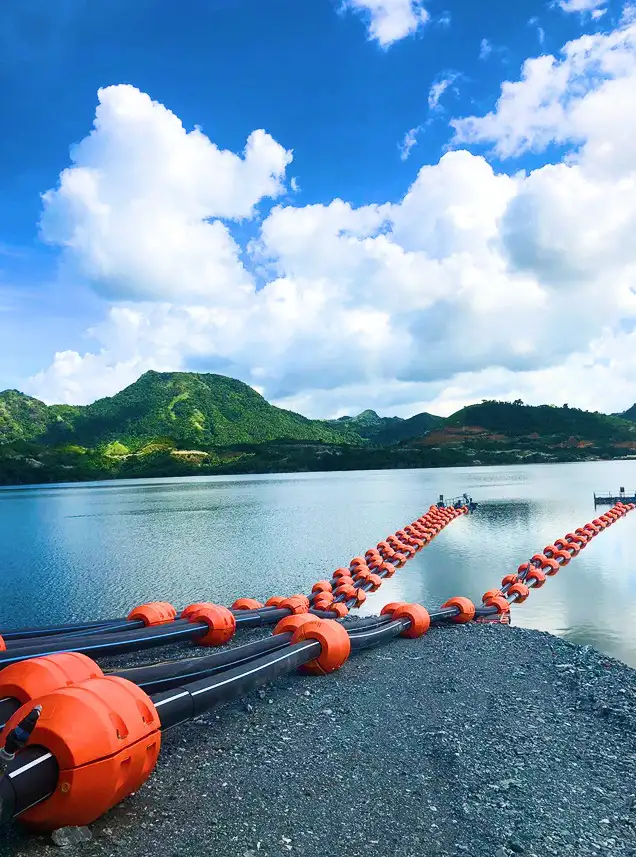
UHMWPE composite pipe pipes represent a significant advancement in piping technology, combining the exceptional properties of UHMW-PE with the structural strength of other materials, most commonly steel. This creates a robust and versatile pipeline solution suitable for a wide range of demanding industrial applications.
Ultra-High Molecular Weight Polyethylene (UHMWPE) Composite Pipe is an advanced piping solution engineered to overcome the severe challenges of abrasion, corrosion, and high pressure found in demanding industrial applications. It combines the exceptional wear resistance of a UHMWPE liner with the structural strength of a reinforcing layer, creating a pipe that significantly outperforms traditional materials like steel, HDPE, and rubber-lined steel in specific environments.
To understand the composite pipe, let's break down its components:
Ultra-High Molecular Weight Polyethylene (UHMWPE): This is not standard polyethylene. UHMWPE is a thermoplastic with extremely long polymer chains, resulting in a molecular weight 10 to 20 times higher than High-Density Polyethylene (HDPE). This unique molecular structure gives it phenomenal properties, most notably the highest abrasion resistance of any thermoplastic.
Composite Pipe: This refers to a pipe constructed from multiple, distinct layers of different materials. Each layer serves a specific function, and their combination results in properties that cannot be achieved by a single material alone.
Therefore, a UHMWPE Composite Pipe is a multi-layered pipe featuring a smooth UHMWPE inner liner that is structurally reinforced to handle high operating pressures.
A UHMWPE composite pipe is typically constructed in three main layers:
Inner Liner (The Wear Surface):
Material: 100% Virgin UHMWPE.
Function: This is the "workhorse" layer that is in direct contact with the transported medium. Its primary role is to provide extreme resistance to abrasion and corrosion. Its exceptionally low coefficient of friction also reduces pumping energy and prevents material buildup (scaling).
Reinforcement Layer (The Muscle):
Material: High-strength steel wire, aramid fiber, or fiberglass wound helically or braided around the inner liner.
Function: This layer provides the mechanical strength to withstand high internal pressures, far exceeding what an unreinforced plastic pipe could handle. The winding pattern is engineered to manage both hoop stress (from pressure) and axial stress (from pulling).
Outer Jacket (The Shield):
Material: Typically High-Density Polyethylene (HDPE).
Function: This outer layer protects the reinforcement layer from external damage, impacts, moisture, and UV degradation. It provides a durable, weather-resistant shell for the pipe.
The combination of UHMW-PE and a reinforcing outer layer results in a pipe with an impressive array of properties:
Exceptional Wear Resistance: This is the hallmark of UHMW-PE. It is several times more wear-resistant than ordinary steel, stainless steel, and other plastics like PVC, HDPE, and nylon. This makes it ideal for transporting abrasive slurries, ore pulp, ash, and other solid-containing media.
High Impact Resistance: UHMW-PE has an incredibly high impact strength, even at low temperatures, making the composite pipe resistant to external impacts and internal pressure surges.
Excellent Corrosion Resistance: UHMW-PE has high chemical stability and can resist a wide range of corrosive media, including acids, alkalis, and salts, over a broad temperature and concentration range.
Low Coefficient of Friction / Self-Lubricating: The extremely smooth surface of UHMW-PE leads to very low friction (lower than that of PTFE). This reduces flow resistance, energy consumption for pumping, and prevents scaling or build-up of transported materials.
Non-Adhesion / Anti-Scaling: The non-stick surface minimizes the adhesion of various substances, including sticky materials, preventing blockages and reducing maintenance needs.
Wide Temperature Range: UHMW-PE pipes can generally be used in temperatures ranging from approximately -50°C to +80°C, and in some cases even as low as -250°C.
Lightweight (for the composite structure): While steel adds weight, the overall composite pipe can still be lighter than equivalent steel pipes, especially when considering the reduced diameter possible due to better flow characteristics. This aids in transport and installation.
Good Thermal Insulation: UHMW-PE has a very low thermal conductivity, which helps in maintaining the temperature of the transported fluid and reduces the need for external insulation.
Long Service Life: The combination of wear, corrosion, and impact resistance significantly extends the lifespan of the pipeline, reducing replacement frequency and costs.
Biocompatibility (for specific grades): Some grades of UHMW-PE are biocompatible, making them suitable for certain medical or food-grade applications.
The manufacturing of UHMW-PE composite pipes typically involves:
UHMW-PE Polymerization: Ethylene monomers are polymerized using Ziegler-Natta catalysts to produce the ultra-high molecular weight polyethylene resin.
Liner Production: The UHMW-PE resin is processed into a pipe liner using techniques like ram extrusion or compression molding. These methods are well-suited for UHMW-PE due to its high melt viscosity.
Composite Formation: The UHMW-PE liner is then integrated with the outer structural layer, usually a steel pipe. This can involve various methods, such as:
Lining: The UHMW-PE pipe is inserted into the steel pipe.
Co-extrusion/Co-molding: In some cases, specialized techniques might be used to bond the layers during the forming process.
Reinforcement Winding: For higher pressure applications, steel wire winding layers can be incorporated between or around the UHMW-PE liner to further enhance compressive strength.
Given their unique combination of properties, UHMW-PE composite pipes are widely used in industries handling abrasive, corrosive, or sticky materials, or requiring high durability and long service life. Common applications include:
Mining and Metallurgy: Transport of ore slurries, tailings, mine backfill, and process water.
Power Industry: Ash and slag transportation in power plants, circulating cooling water pipelines, anti-corrosion lines in water treatment facilities.
Coal Industry: High-pressure transportation of pulverized coal, coal water slurry, and mud; ventilation and water supply systems in mines.
Petrochemical Industry: Conveying various corrosive media and crude oil.
Dredging: Transport of sediment and sand.
Chemical Industry: Transportation of a wide range of corrosive and abrasive chemicals.
Municipal Utilities: Sewage treatment, industrial waste disposal, and domestic water supply (where appropriate grades are used).
Other Industrial Applications: Conveyor systems, chutes, silos, and various wear-resistant components in manufacturing.
In summary, Ultra-High Molecular Weight Polyethylene composite pipes offer a high-performance solution for challenging fluid and slurry transfer applications, providing extended service life, reduced maintenance, and improved operational efficiency compared to traditional piping materials.
